Cover image of Spotted Thick-Knee by Kevin Lavery – Klipriversberg Nature Reserve, Gauteng – BirdPix No. 220757
Thick-knees belong to the Family: BURHINIDAE. This family also includes Stone-Curlews. They are medium-to large sized, terrestrial waders. They are generally found in semi-arid to arid, open areas and only a few species are associated with water.
Identification
The Spotted Thick-knee is a large, long-legged wader, with strikingly large eyes. The combination of long legs, overall spotted appearance and large yellow eyes is distinctive.

Riversdale district, Western Cape
Photo by Terry Terblanche
The forehead, crown, nape, ear coverts and hind neck are buff-coloured with darker brown streaks. The white supercilium is short and broad. A conspicuous white stripe is present below the eye, reaching from the gape or frons to the cheek.
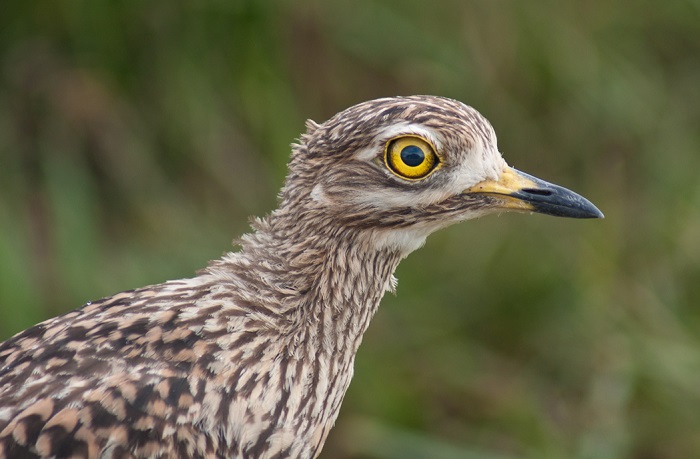
Rietvlei Nature Reserve, Gauteng
Photo by Werner Van Goethem
The upper parts and tail are mostly buff-coloured with bold dark brown to black spots and blotches. The tail is fairly long and extends well beyond the wing tips at rest. The throat is white and the underparts, from the neck to the lower breast are pale buff with fine dark streaks. The belly and under tail coverts are white with scattered dark streaks.

Hanover district, Northern Cape
Photo by Ryan Tippett
In flight the Spotted Thick-knee appears long-winged and long-tailed. The flight feathers are black with white patches at the base of the primaries. The bill is black with a yellow base and the legs and feet are dull yellow. The large eyes are rich yellow. The sexes are alike.
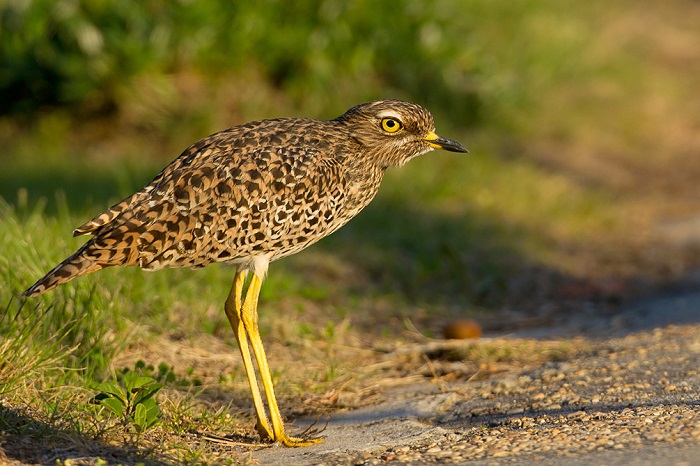
St. Francis Bay, Eastern Cape
Photo by Gregg Darling
Juveniles resemble the adults but are more heavily streaked on the upperparts and have a less blotched appearance. They also have finer streaking on the fore-neck and breast.
The Spotted Thick-knee is only likely to be confused with the slightly smaller Water Thick-knee (Burhinus vermiculatus), but lacks that species greyish wing panel and thin white wing bar. The two species frequently co-occur, although their preferred habitats differ.
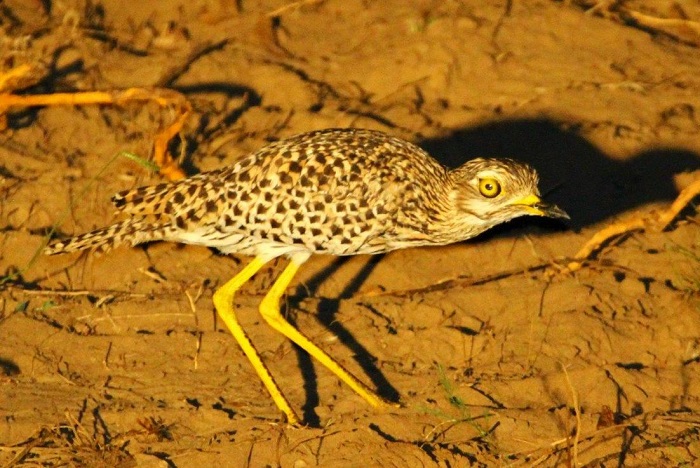
iSimangaliso Wetlands Park, KwaZulu-Natal
Photo by Mark Stanton
Status and Distribution
The Spotted Thick-knee is generally a fairly common resident with some local movement in the non-breeding season.
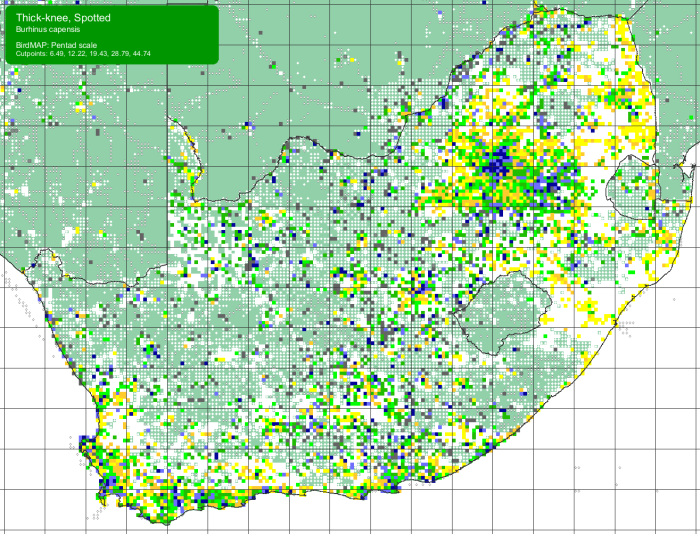
The Spotted Thick-knee is found across most of sub-Saharan Africa but is absent from the tropical forest zone, and the driest parts of East Africa. There are also isolated populations in the south-west of the Arabian Peninsula. It is widespread throughout southern Africa but avoids the most arid parts of the Namib Desert, the high Drakensberg and the eastern highlands of Zimbabwe.

Klipriviersberg Nature Reserve, Gauteng
Photo by Kevin Lavery
The Spotted Thick-knee is not threatened in southern Africa due to its adaptability to man-modified habitats. As a result its historical range and abundance have probably not changed much.
The clearing of bush and forest has helped the Spotted Thick-knee to extend its range into formerly unsuitable areas. On the other hand, the species is no longer found in Lesotho and the former Transkei in the Eastern Cape. These regions have become uninhabitable to the Spotted Thick-knee due to the constant presence of people and livestock (especially free-range pigs) making breeding virtually impossible. Under less extreme conditions the Spotted Thick-Knee adapts well to habitats modified by human activity.

Klerksdorp district, North West
Photo by Tony Archer
The Spotted Thick-knee does face a few threats: It was hunted historically but is no longer regarded as a gamebird. They are sometimes shot at airports due to a risk of collision with aircraft. Additionally, in southern Africa large numbers may be killed on roads at night.
Habitat

Carnarvon district, Northern Cape
Photo by Ryan Tippett
The Spotted Thick-knee prefers open habitats with sparse ground cover and patches of bare soil, especially on stony ground. It inhabits open grassland and savanna, also woodland edges, fynbos, semi-arid Karoo scrub and low stony hills, but avoids true desert. The Spotted Thick-knee requires some nearby cover to rest up in during the day such as bushes, long grass or under low hanging tree branches etc. They are often encountered on gravel roads at night and sometimes occur on beaches, especially in the Eastern Cape.

Paarden Eiland, Cape Town, Western Cape
Photo by Les Underhill
The Spotted Thick-knee has adapted well to man-modified habitats like cultivated and overgrazed lands. It commonly occurs and breeds in urban environments in South Africa, even close to city centres. Urban habitats include large lawns, playing fields, gardens, parks and cemeteries. Interestingly, the Spotted Thick-Knee is absent from suburban gardens in Botswana.
Behaviour
The Spotted Thick-knee is normally encountered solitarily or in pairs when breeding, otherwise often gregarious, forming loose daytime roosts of up to 70 birds. The Spotted Thick-knee is most vocal at night and can be rather noisy at times. They also call on overcast days, especially after rain.
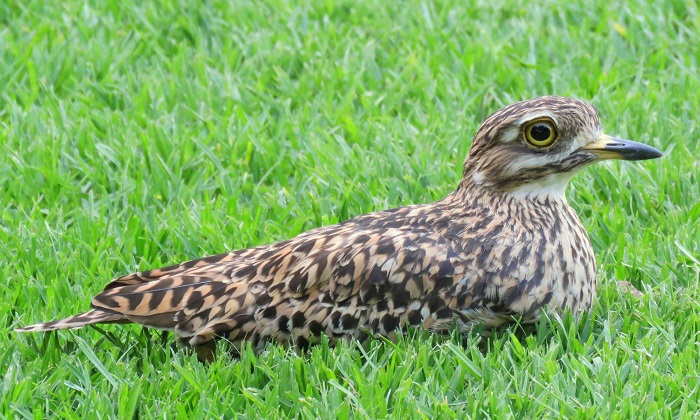
Northcliff, Johannesburg, Gauteng
Photo by Anthony Paton
The Spotted Thick-knee is largely crepuscular and nocturnal. It roosts by day, standing or crouching in the shade of a bush or tree, often in the cover of grass or weedy growth. Sleeps by crouching with the legs covered by the breast and with the neck and head resting on the ground. On hot days they may lie down with both legs stretched out behind the body to aid in cooling.
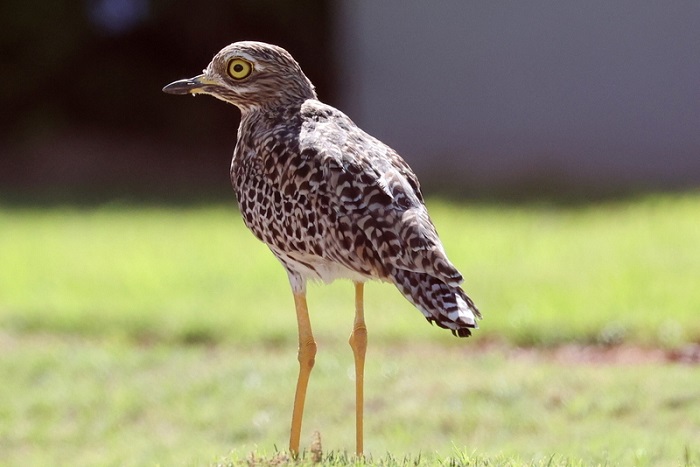
Somerset West, Western Cape
Photo by Corrie du Toit
When disturbed the Spotted Thick-knee usually runs off with its head held low and flies strongly with shallow, stiff wing-beats. Birds will often hold their wings out momentarily upon landing and usually crouch or stand still until the perceived danger has passed.
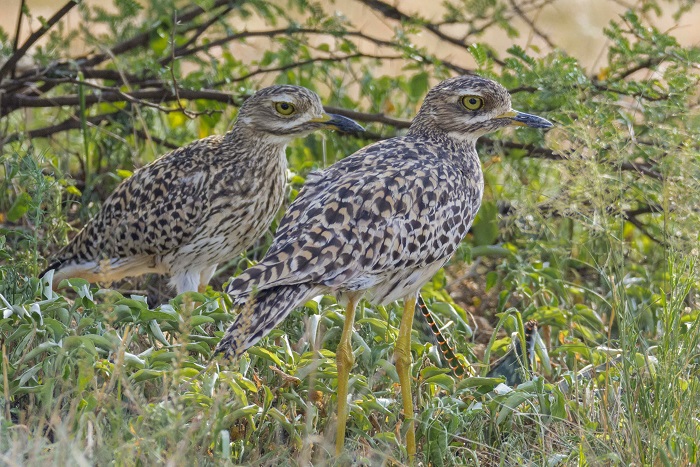
Klerksdorp district, North West
Photo by Tony Archer
The Spotted Thick-knee forages in a plover-like manner, running several steps forward before pausing, followed by a quick peck at its prey. Eats mainly arthropods, especially insects. Beetles and termites are preferred but also takes locusts, earwigs, bugs, caterpillars, moths, crickets, bees and ants etc. Also consumes spiders, solifuges, scorpions, snails and worms. On rare occasions may eat small mammals, amphibians and thread snakes. Stomach contents of the Spotted Thick-knee usually contain substantial amounts of grit to aid in digestion.
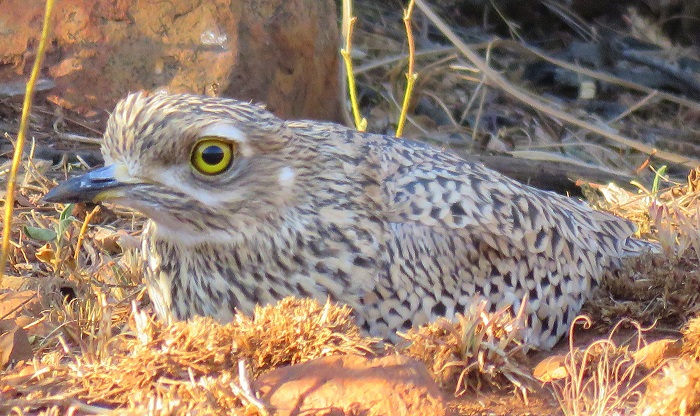
Alberton, Johannesburg, Gauteng
Photo by Anthony Paton
The Spotted Thick-knee is a monogamous, solitary nester. They are usually territorial, but loosely colonial breeding has been observed. Pairs are believed to maintain long-term bonds.
The nest is simply a shallow scrape on the ground, usually in the open among grass tufts or next to a stone or shrub. The nest is normally placed at a site with good all round visibility. The nest scrape may be lined or ringed with twigs, antelope droppings, leaves or stones but is sometimes left unlined.
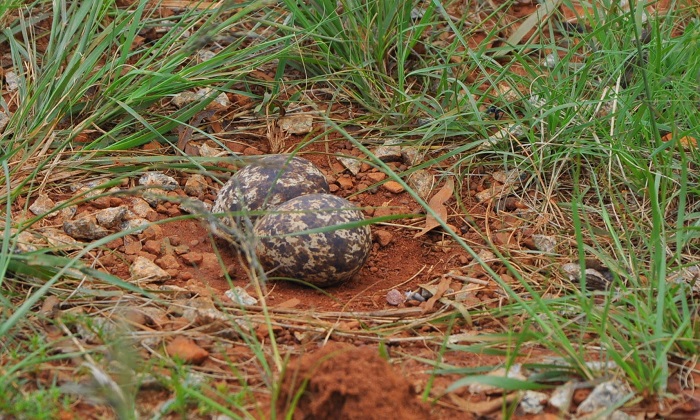
Rietvlei Nature Reserve, Gauteng
Photo by Bryan Groom
Eggs are mainly laid from September to December in southern Africa. Most pairs lay two eggs per clutch. The egg colour is variable ranging from dull tawny to yellowish grey and heavily blotched in dark yellowish-brown with grey. The Spotted Thick-knee will usually lay a replacement clutch if the eggs are lost, with up to 4 clutches laid per season.
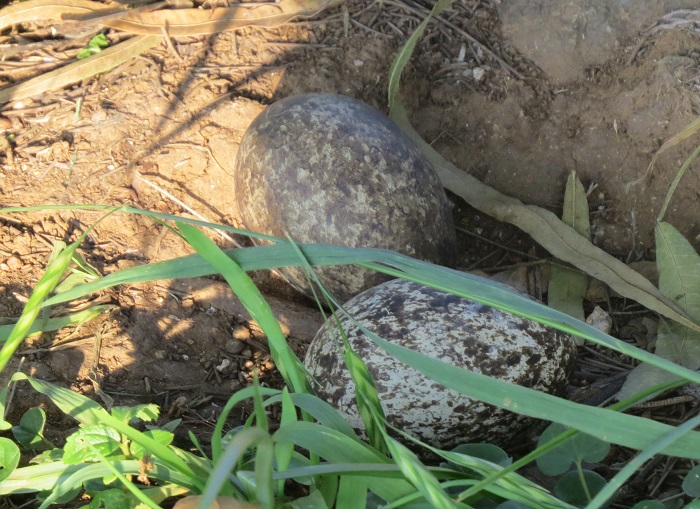
Johannesburg, Gauteng
Photo by Anthony Paton
Incubation begins around 24 hours after the full clutch has been laid. Both sexes share incubation duties, but females spend the most time on the eggs. The incubation period can last for up to 30 days. The non-incubating parent usually remains nearby.
The eggs hatch synchronously and the empty shell fragments are eaten by the adults. Newly hatched young are precocial and are well camouflaged. Chicks leave the nest within a day and are fed by both parents.
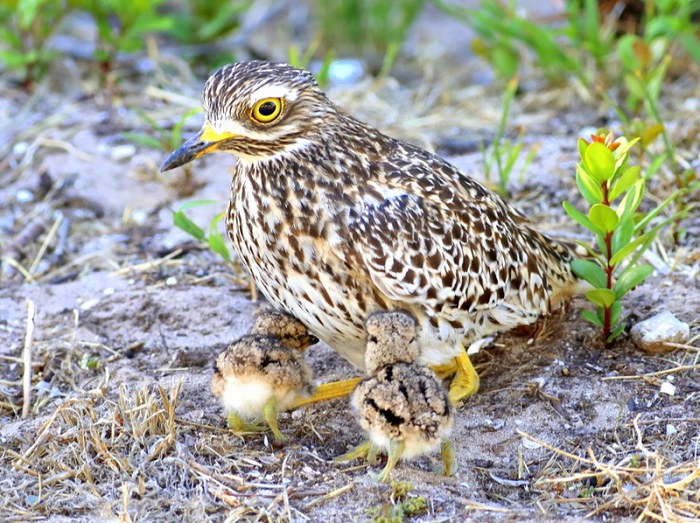
Franskraal, Western Cape
Photo by Corrie du Toit
Chicks crouch in response to danger, lying flat with their heads outstretched. Adults are known to use broken-wing, broken-back and broken-leg displays to draw predators away from the eggs and chicks. The fledging period takes up to 8 weeks.
Further Resources
Species text from the first Southern African Bird Atlas Project (SABAP1), 1997.
The use of photographs by Anthony Paton, Bryan Groom, Corrie du Toit, Gregg Darling, Kevin Lavery, Les Underhill, Mark Stanton, Terry Terblanche, Tony Archer and Werner Van Goethem is acknowledged.
Virtual Museum (BirdPix > Search VM > By Scientific or Common Name).
Other common names: Spotted Dikkop (Alt. English); Gewone dikkop (Afrikaans); umBangaqhwa, umJenjana (Zulu); Ingqangqoto (Xhosa); Kgoadirê, Mongwangwa, Tswangtswang (Tswana); Kaapse Griel (Dutch); Oedicnème tachard (French); Kaptriel, Bändertriel (German); Alcaravão do Cabo (Portuguese)
A list of bird species in this format is available here.
Recommended citation format: Tippett RM 2024. Spotted Thick-knee Burhinus capensis. Biodiversity and Development Institute. Available online at https://thebdi.org/2024/07/09/spotted-thick-knee-burhinus-capensis/
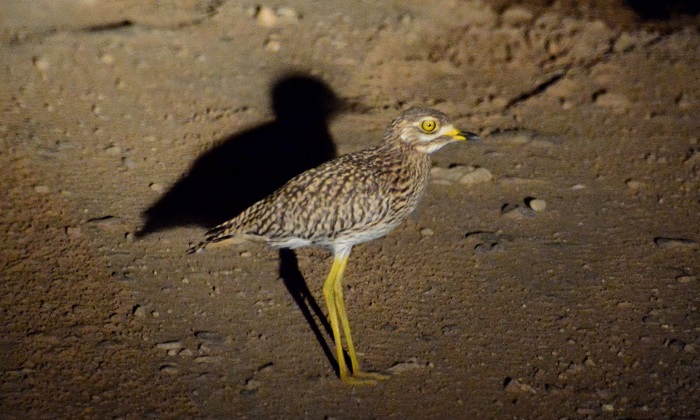
Karoo Gariep Nature Reserve, Northern Cape
Photo by Ryan Tippett

